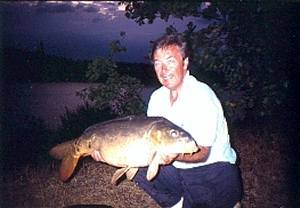How do I catch carp from a big water which holds relatively few fish?
The first job is to spend time getting to know the topography of the water, ideally via a boat (never, ever go in a boat without wearing a lifejacket) and an echo-sounder. The next best option is a boat and "prodding pole", but if circumstances make the use of a boat impossible, then by means of a plumbing rod from the bank.
Then comes observation. Carp are usually fairly cooperative in that they cruise, bask, roll, jump etc. By marrying these observations with weather conditions – especially the wind direction – and knowledge of the water’s topography, it should be possible to build up a preliminary picture of which areas are favoured by carp.
While any standard carp fishing approach might produce results, one of the most effective is ‘stalking’. I put the word in inverted commas because it is not confined to conventional peering under-trees type stalking (although that can be an excellent tactic), but includes looking for where fish are rolling5 head-and-shouldering, bubbling, mud-stirring etc. Having found the fish, it is essential that they be approached ultra-cautiously. Carp which are rarely fished for tend to be extremely "spooky" and will not tolerate heavy lead or bait bombardment. A light lead – or no lead at all – and a single hookbait is the best bet. If the nature of the bait permits, a stringer might be incorporated.

While I have caught carp by stalking, my preferred approach – and the one which has been most successful for me – is to select an area of the lake (or more likely, pit) and wait for the conditions which suit that area. Let me explain by giving a "for instance". Suppose my plumbing/echo-sounding etc reveals a tennis-court size plateau within casting distance of the north-east comer. If the carp in my chosen water behave typically, they will move to the plateau when a nice, mellow south-west wind springs up. If I can get to the plateau ahead of the wind -before it springs up, in other words – I will have feed items and baits in position, awaiting the arrival of the carp. If the wind is already blowing, which means carp will probably already be there, I will dispense with free feed and rely solely on stringers.
A related approach is to fish the corners – if the water has them, that is. I will opt for the corner into which the wind blows. The bottle-neck nature of a comer means that carp tend to accumulate in a relatively small area – which is an obvious advantage when there are only a few in the water.
The upside of fishing sparsely stocked waters is that the carp are likely to have been neglected, so they are usually quite responsive to baits. In one of my articles or books, when talking of such fish, I described them as "easy fish in difficult waters" – by which I mean that if you find them and don’t alarm them, they can be quite easy to tempt. The downside, of course, is that they are often very difficult to find.

As regards actual tactics; baits most likely to be taken from the "off" are naturals such as worms – with semi-naturals such as cockles a good bet, too. Next on my list are particles; notably sweetcom, chick peas, maple peas and tigernuts – they tend to be more instant than are boilies. I always take about half a kilo of boilies, though, and when I pack up to go home, I scatter them where I hope they will be found by carp. After half a dozen or so such introductions I would start incorporating boilies into my actual fishing. In my experience, the best boilies to use are birdfood or cereal based high-attract sweet tasting versions incorporating such flavours as Scopex, Strawberry, Peach, Maplecreme etc (readymades are ideal). Fishmeal boilies might come later in the campaign, but would not be my first choice because it seems to take a long while for non-boilie oriented carp to acquire a taste for them.
Ideally I would start my fishing in early April, fish through the spring (assuming no close season is in force on the water), and continue until late October. November to March I would choose somewhere less demanding.
Jim Gibbinson








